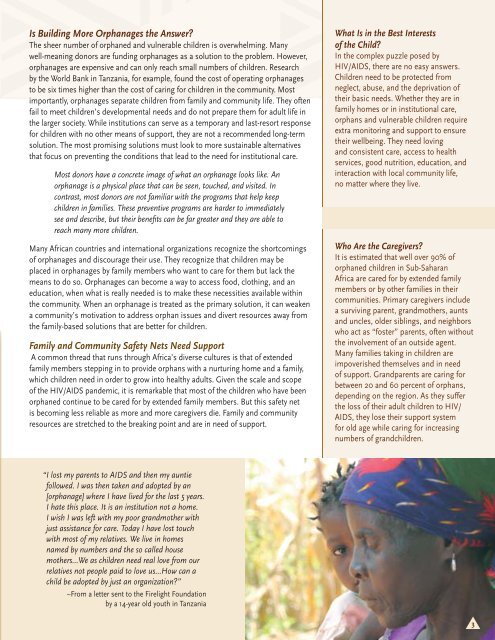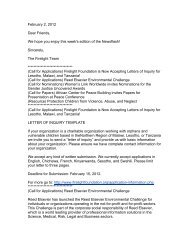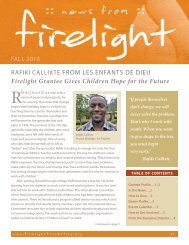From Faith to Action - Faith to Action Initiative
From Faith to Action - Faith to Action Initiative
From Faith to Action - Faith to Action Initiative
- No tags were found...
Create successful ePaper yourself
Turn your PDF publications into a flip-book with our unique Google optimized e-Paper software.
Is Building More Orphanages the Answer?The sheer number of orphaned and vulnerable children is overwhelming. Manywell-meaning donors are funding orphanages as a solution <strong>to</strong> the problem. However,orphanages are expensive and can only reach small numbers of children. Researchby the World Bank in Tanzania, for example, found the cost of operating orphanages<strong>to</strong> be six times higher than the cost of caring for children in the community. Mostimportantly, orphanages separate children from family and community life. They oftenfail <strong>to</strong> meet children’s developmental needs and do not prepare them for adult life inthe larger society. While institutions can serve as a temporary and last-resort responsefor children with no other means of support, they are not a recommended long-termsolution. The most promising solutions must look <strong>to</strong> more sustainable alternativesthat focus on preventing the conditions that lead <strong>to</strong> the need for institutional care.Most donors have a concrete image of what an orphanage looks like. Anorphanage is a physical place that can be seen, <strong>to</strong>uched, and visited. Incontrast, most donors are not familiar with the programs that help keepchildren in families. These preventive programs are harder <strong>to</strong> immediatelysee and describe, but their benefi ts can be far greater and they are able <strong>to</strong>reach many more children.Many African countries and international organizations recognize the shortcomingsof orphanages and discourage their use. They recognize that children may beplaced in orphanages by family members who want <strong>to</strong> care for them but lack themeans <strong>to</strong> do so. Orphanages can become a way <strong>to</strong> access food, clothing, and aneducation, when what is really needed is <strong>to</strong> make these necessities available withinthe community. When an orphanage is treated as the primary solution, it can weakena community’s motivation <strong>to</strong> address orphan issues and divert resources away fromthe family-based solutions that are better for children.Family and Community Safety Nets Need SupportA common thread that runs through Africa’s diverse cultures is that of extendedfamily members stepping in <strong>to</strong> provide orphans with a nurturing home and a family,which children need in order <strong>to</strong> grow in<strong>to</strong> healthy adults. Given the scale and scopeof the HIV/AIDS pandemic, it is remarkable that most of the children who have beenorphaned continue <strong>to</strong> be cared for by extended family members. But this safety netis becoming less reliable as more and more caregivers die. Family and communityresources are stretched <strong>to</strong> the breaking point and are in need of support.What Is in the Best Interestsof the Child?In the complex puzzle posed byHIV/AIDS, there are no easy answers.Children need <strong>to</strong> be protected fromneglect, abuse, and the deprivation oftheir basic needs. Whether they are infamily homes or in institutional care,orphans and vulnerable children requireextra moni<strong>to</strong>ring and support <strong>to</strong> ensuretheir wellbeing. They need lovingand consistent care, access <strong>to</strong> healthservices, good nutrition, education, andinteraction with local community life,no matter where they live.Who Are the Caregivers?It is estimated that well over 90% oforphaned children in Sub-SaharanAfrica are cared for by extended familymembers or by other families in theircommunities. Primary caregivers includea surviving parent, grandmothers, auntsand uncles, older siblings, and neighborswho act as “foster” parents, often withoutthe involvement of an outside agent.Many families taking in children areimpoverished themselves and in needof support. Grandparents are caring forbetween 20 and 60 percent of orphans,depending on the region. As they sufferthe loss of their adult children <strong>to</strong> HIV/AIDS, they lose their support systemfor old age while caring for increasingnumbers of grandchildren.“ I lost my parents <strong>to</strong> AIDS and then my auntiefollowed. I was then taken and adopted by an[orphanage] where I have lived for the last 5 years.I hate this place. It is an institution not a home.I wish I was left with my poor grandmother withjust assistance for care. Today I have lost <strong>to</strong>uchwith most of my relatives. We live in homesnamed by numbers and the so called housemothers…We as children need real love from ourrelatives not people paid <strong>to</strong> love us…How can achild be adopted by just an organization?”~<strong>From</strong> a letter sent <strong>to</strong> the Firelight Foundationby a 14-year old youth in Tanzania3








